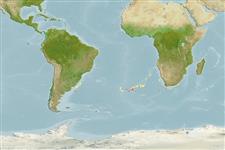>
Scombriformes (Mackerels) >
Trichiuridae (Cutlassfishes) > Aphanopodinae
Etymology: Aphanopus: Greek, aphanes = hidden + Greek, pous = foot (Ref. 45335).
Eponymy: Sergey Vladimirovich Mikhailin (1943–1981) was a Russian ichthyologist at the All-Union Research lnstitute of Marine Fisheries and Oceanography, Moscow. [...] (Ref. 128868), visit book page.
Environment: milieu / climate zone / depth range / distribution range
Écologie
marin benthopélagique; profondeur 905 - 2000 m (Ref. 6181). Deep-water; 23°S - 39°S, 54°W - 84°E (Ref. 6181)
Southeast Atlantic: Namibia and at Walvis Ridge. Southwest Atlantic: off Argentina. Indian Ocean: on seamounts off Mozambique and the West Australian Ridges. Western Pacific: Southeast Australia, North Island in New Zealand and the Challenger Plateau (Ref. 41692).
Taille / Poids / Âge
Maturity: Lm ? range ? - ? cm
Max length : 90.0 cm TL mâle / non sexé; (Ref. 36731)
Épines dorsales (Total) : 42 - 45; Rayons mous dorsaux (Total) : 61 - 66; Épines anales: 2; Rayons mous anaux: 51 - 57; Vertèbres: 111 - 117. Pelvic fins represented by a single spine in juveniles, inserted before the base of the pectoral fins, but entirely absent in adults. Body color is coppery black with iridescent tint. The inside of the mouth and gill cavities black.
Occurs on the continental slope or underwater rises (Ref. 10818).
Life cycle and mating behavior
Maturité | Reproduction | Frai | Œufs | Fécondité | Larves
Nakamura, I. and N.V. Parin, 1993. FAO Species Catalogue. Vol. 15. Snake mackerels and cutlassfishes of the world (families Gempylidae and Trichiuridae). An annotated and illustrated catalogue of the snake mackerels, snoeks, escolars, gemfishes, sackfishes, domine, oilfish, cutlassfishes,. scabbardfishes, hairtails, and frostfishes known to date. FAO Fish. Synop. 125(15):136 p. (Ref. 6181)
Statut dans la liste rouge de l'IUCN (Ref. 130435: Version 2024-1)
Menace pour l'homme
Harmless
Utilisations par l'homme
Pêcheries: sans intérêt
Outils
Articles particuliers
Télécharger en XML
Sources Internet
Estimates based on models
Preferred temperature (Ref.
123201): 2.5 - 3.1, mean 2.7 °C (based on 61 cells).
Phylogenetic diversity index (Ref.
82804): PD
50 = 0.5078 [Uniqueness, from 0.5 = low to 2.0 = high].
Bayesian length-weight: a=0.00046 (0.00020 - 0.00105), b=3.12 (2.92 - 3.32), in cm total length, based on LWR estimates for this (Sub)family-body shape (Ref.
93245).
Niveau trophique (Ref.
69278): 4.1 ±0.7 se; based on size and trophs of closest relatives
Résilience (Ref.
120179): Faible, temps minimum de doublement de population : 4,5 à 14 années (Assuming tmax>10).
Fishing Vulnerability (Ref.
59153): High vulnerability (56 of 100).
